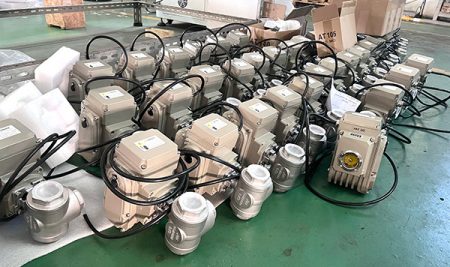
Actuated valves are very important in many industries. These include oil and gas, water treatment, chemical making, and food processing. The table below shows how much each industry uses actuated valves:
| Industry | Market Share / Revenue Share (2022) | Key Applications |
|---|---|---|
| Oil and Gas | 26.7% | Extraction, refining, transport |
| Pneumatic Actuators | 36.2% | Mining, energy, chemical, oil and gas, food and beverage |
| Water & Wastewater | 6.7% CAGR (fastest growing) | Water supply, wastewater treatment |
Operators pick the best valve actuator for their needs. This helps make things safer, faster, and more reliable. Smart actuated valve systems control water flow by themselves. They help stop mistakes and let people check them from far away. Using electric ball valve and pneumatic ball valve solutions makes things more exact. It also means less fixing is needed in tough jobs.
Oil & Gas
Actuated Valve Applications
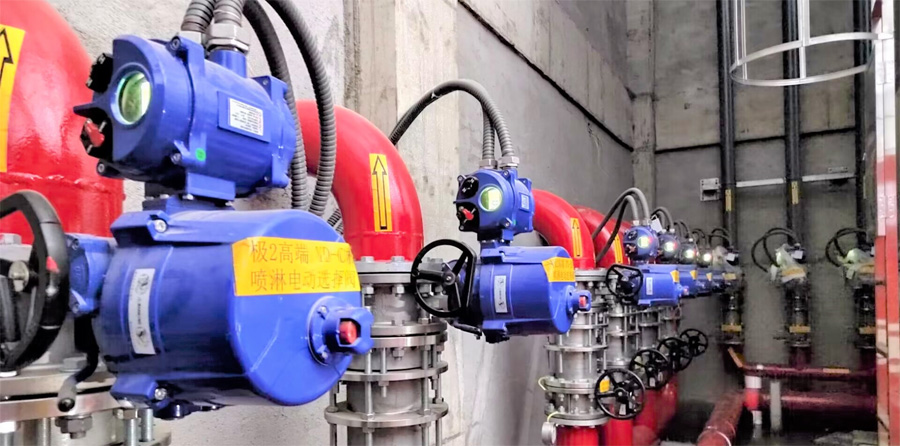
Flow Control
Oil and gas companies use actuated valve systems to control flow. These valves are used in wells, separators, pipelines, plants, storage, and offshore sites. Operators use valve actuators to move oil, gas, and finished products. In wells, actuated valves handle high pressure and dirty fluids. This keeps flow steady and safe. Separators use these valves to control and separate fluids during oil treatment. Pipelines need actuated valves to control flow and close off parts for repairs or emergencies. Plants use actuated valves to guide fluids during distillation and cracking. Storage tanks use actuated valves to close off tanks and help with loading or unloading. Offshore sites need valves that do not rust and can be controlled from far away.
| Application Stage | Primary Use of Actuated Valves | Impact on Operational Efficiency |
|---|---|---|
| Extraction Wells | Control flow of oil and gas from reservoirs | Withstand high pressures and impurities, enabling reliable flow control |
| Separators | Isolate and regulate fluid flow during crude oil treatment | Provide durable sealing in contaminated environments |
| Pipelines | Control flow and isolate sections for maintenance or emergencies | Enable automation for long-distance operations, reducing manual intervention |
| Refining Plants | Direct and modulate fluid flow during distillation and cracking | Handle high temperatures and corrosive fluids, improving process control |
| Storage Systems | Isolate tanks and manage loading/unloading | Enhance safety and operational flexibility |
| Offshore Facilities | Control flows on platforms and subsea installations | Corrosion-resistant and compatible with remote automation, improving safety and efficiency |
Pipeline Isolation
Pipeline isolation is very important in oil and gas work. Operators use actuated valves to close off parts of a pipeline for repairs or emergencies. Emergency shutoff valves close quickly to stop danger and limit harm. Automation helps close pipelines without people doing it by hand. This makes things safer and helps work go faster.
Valve Actuators Used
Oil and gas sites use pneumatic, hydraulic, and electric valve actuators. Pneumatic valve actuators work fast, last long, and are safe in dangerous places. They are good for places where explosions could happen and have safety features. Hydraulic valve actuators are strong and precise, so they work well for big pipeline valves. They can handle high pressure and work quickly. Electric valve actuators are easy to use and reliable, especially if air is not clean. Operators pick the actuator type based on the valve, power, movement needed, how exact it must be, the environment, and safety needs.
| Valve Actuator Type | Advantages | Disadvantages | Typical Applications |
|---|---|---|---|
| Pneumatic | Fast cycle time, durability, explosion-proof safety features, fail-safe options | Limited force output, requires compressed air, fast cycling can cause water hammer | Process control, chemical industry, food and beverage |
| Electric | Reliable, easy to use, no need for compressed air or fluid, modular control options | Slower cycle time, may need extra control components, typically less durable than pneumatic | Power generation, water treatment, pharmaceutical |
| Hydraulic | High force output, precision, fast cycle times, fail-safe options | Higher cost, complex installation, risk of fluid leakage | Oil and gas pipelines, power plants, gas pipelines |
Operational Benefits
Oil and gas sites get many benefits from actuated valves:
- Automated valves help stop mistakes by needing less human work.
- Remote control means workers do not have to be near dangerous valves, so they are safer.
- Real-time checks let workers watch valve performance and spot problems early.
- Actuated valves make things more accurate and quick, so unsafe delays do not happen.
- Automation helps with maintenance and safety, so teams can focus on watching and improving safety.
Tip: Using automation in oil production and pipelines makes work faster, safer, and better for the environment.
Actuated valve systems in oil and gas give exact flow control, safe pipeline isolation, and better safety. Operators get more done, have less downtime, and follow safety rules by picking the right valve actuators for each job.
Power Generation
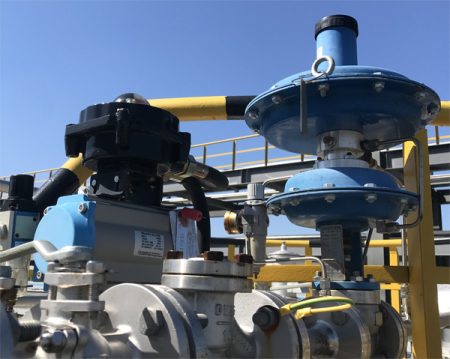
Power plants need actuated valve technology to work safely and well. These plants use valve actuators in many ways. They use them in steam lines, cooling systems, and safety circuits. Each job needs a special actuator type and features. This is because power plants can be tough places with high pressure.
Applications
Steam Lines
Operators use actuated valves to control steam flow in steam lines. These valves change how much steam goes into turbines and boilers. Gate valves help control water for boilers. Globe valves help with water and turbine control. The right actuator moves the valve exactly, even when it is hot and under pressure. Hydraulic valve actuators are strong and work well for big valves. They are good for high pressure jobs. Electric actuators give fine control and quick feedback. This helps keep the process steady.
Cooling Systems
Cooling systems in power plants need good valve actuators. Ball valves and butterfly valves move cooling water to different places. These valves must open and close fast to stop overheating. Pneumatic actuators can handle lots of use and react quickly. This makes them good for cooling water control. Electric actuators are accurate and help make small changes. They support automatic changes based on what the system needs.
Note: Smart valve technology uses sensors and actuators. It lets workers watch valves in real time and fix problems before they get worse. This means less downtime and longer valve life.
Valve Actuators Selection
Picking the right actuator depends on many things. Operators look at valve type, how much force is needed, safety needs, and where the valve is used. The table below shows how hydraulic valve actuators and electric actuators compare in power plants:
| Criteria / Aspect | Hydraulic Valve Actuators | Electric Actuators |
|---|---|---|
| Force Output | High torque for large valves and high pressure applications | Reliable, precise control for smaller valves |
| Fail-Safe Operation | Spring-return or accumulator tanks provide fail-safe positions | Battery backup or electro-hydraulic options available |
| Maintenance | Requires regular checks for leaks and fluid quality | Lower maintenance, but needs stable power supply |
| Application Suitability | Best for high pressure applications and emergency shut-off | Ideal for automated systems and clean environments |
| Speed and Frequency | Handles moderate to high frequency; speed controlled by fluid flow | Suitable for frequent starts; speed control needs gear or circuit adjustments |
Operators pick hydraulic valve actuators for big valves and high pressure. Electric actuators are better when control and feedback are important.
Key Advantages
Actuated valve systems help power plants in many ways:
- They keep people away from dangerous systems, making things safer.
- Automated valves act fast if something goes wrong, protecting people and machines.
- Exact flow control keeps temperature and pressure steady, making things work better.
- These systems can connect to control systems like PLCs and SCADA. This lets workers watch and fix things from far away.
- They help meet safety and environmental rules, and save energy and cut waste.
Power plants work better and break down less when they use the right valve actuators. Automated control, real-time data, and fixing problems early help keep everything running, even when things get tough.
HVAC & Building Systems
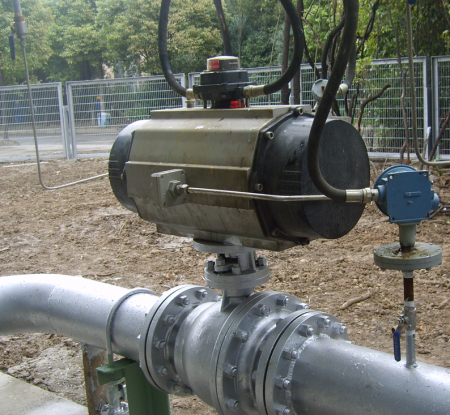
Common Applications
HVAC and building systems use actuated valves to control air, water, and fluids. These valves help keep the temperature and humidity right inside buildings. Facility managers use actuated valves to send hot or cold water where it is needed. This keeps rooms comfortable and helps save energy.
Operators often pick pneumatic ball valves and actuators for good water flow control. These parts last longer and let different rooms have their own temperatures. Programmable ball valves let workers change settings from far away. This saves energy and makes people more comfortable. Air actuated ball valves work fast and do not need much fixing. They are great for important spots in HVAC systems.
Thermal valve actuators are also important. They change fluid flow when the temperature changes. This means HVAC systems only run when needed. It stops machines from turning on and off too much. This saves energy and cuts down on pollution. When actuated valves work with building management systems, they can change settings by themselves. They can react to how many people are in the building or what the weather is like. This makes fixing things easier and helps the building be more eco-friendly.
Note: Actuated valves in HVAC systems help use less energy, meet green building rules, and make systems work better.
The table below shows where actuated valves are used in HVAC and building systems:
| Application Area | Valve Type/Actuator | Benefit |
|---|---|---|
| Chilled/Hot Water Circuits | Pneumatic/Electric Ball | Good flow control, saves energy |
| Air Handling Units | Electric Rotary/Linear | Puts dampers in the right spot |
| Underfloor Heating | Thermal Valve Actuators | Keeps temperature steady, less cycling |
| Zoning Systems | Programmable Ball Valves | Lets each area have its own setting |
| Building Automation | Integrated Electric Actuators | Watch from far away, fix problems early |
Electric valve
Electric valve actuators are now very important in building automation. They use electricity to move valves and dampers. This lets them open, close, or adjust valves very exactly. Facility teams use electric valve actuators to control temperature and flow better. This helps save energy.
New actuator technology makes them faster and smarter. Smart actuators can talk to building management systems. This lets workers see how they are working and find problems early. It also helps plan repairs and keeps things running longer.
Electric valve actuators help buildings use less energy and make less pollution. They work well even in tough places and do not break easily. In smart cities and green energy projects, electric valve actuators help control water, waste, and energy. This helps make cities cleaner and greener.
Facility managers like these actuators because they are safe. They can shut down by themselves and tell workers if something is wrong. They can also work with IoT and digital twins. This makes work easier and helps use resources better. Electric valve actuators are important for making buildings ready for the future and helping the planet.
Water & Wastewater

Common Applications
Water and wastewater plants use actuated valves for many jobs. These valves help control water supply, cleaning, and waste. Operators use actuated valves to move water without doing it by hand. This makes water flow better in treatment plants and pipes.
Flow Regulation
It is very important to control water flow in treatment. Operators use actuated valves to change water flow as needed. This makes sure each step gets the right amount of water. Automated valves help keep pressure steady and stop leaks. Operators can watch the system in real time and use less energy.
Treatment Stages
Every step in cleaning water needs good valve control. Actuated valves move water and chemicals during cleaning, disinfecting, and sludge work. Automation helps pumps and chemical use, so workers do less by hand. Operators can watch and control many sites from one place. This helps them act fast in emergencies and keep getting better.
Operators can connect actuated valves to SCADA systems for a full view of the plant. This helps fix problems before they get big and keeps workers safe by automating risky jobs.
Actuator Types
Operators pick actuators based on what each job needs. Electric actuators are used a lot in water plants. They are reliable, exact, and do not pollute. Pneumatic actuators are good for outside or risky places. They work fast and have safety features. Hydraulic actuators are not used as much but are strong for hard jobs. The choice depends on the valve, where it is, and how it is controlled.
| Actuator Type | Advantages | Typical Use Cases |
|---|---|---|
| Electric | Reliable, precise, zero emissions | Water distribution, treatment |
| Pneumatic | Fast, safe, cost-effective | Outdoor, hazardous environments |
| Hydraulic | High force, remote operation | Isolated or high-pressure systems |
Benefits
Actuated valves give many good things for water and wastewater work:
- Good flow control helps water move and get cleaned well.
- Automation means workers handle fewer dangerous chemicals and waste.
- Watching the system in real time saves energy and money.
- SCADA lets workers change valves from far away and fix things early.
- Strong valves and actuators last long and need little fixing.
- Meeting EPA, ANSI, and city rules keeps water safe and legal.
- Automation helps protect the environment by stopping leaks and using chemicals better.
Actuated valves are very important for safe, good, and steady water systems. They help plants work well and follow the rules.
Chemical & Pharmaceutical

Applications
Dosing & Mixing
Chemical and pharmaceutical plants use actuated valve systems for dosing and mixing. These jobs need very exact measuring and delivery of liquids, powders, or gases. Operators use valve actuators to move ingredients into reactors, mixers, and tanks. This makes sure each batch gets the right amount of every part. This is important for good products and safety. Automated valves also handle dangerous or harsh materials. This means workers do not have to touch them as much, so they stay safer.
Pressure Control
Pressure control is also very important in these plants. Operators use valve actuators to keep pressure steady in pipes, reactors, and storage tanks. Keeping pressure steady stops leaks and equipment problems. Automated control valves react fast to changes in the process. They keep pressure safe. These systems can also help shut things down quickly in emergencies. This protects people and the environment.
Valve Actuators in Use
Chemical and pharmaceutical plants often use pneumatic and electric valve actuators. Pneumatic actuators use air to move valves fast and reliably. They work well where safety and cleanliness are needed, like cleanrooms or risky areas. Pneumatic types, like piston and diaphragm, let operators pick what works best. Electric valve actuators move valves exactly and keep things clean. They do not need air or fluids, so they are good for sterile places. Their design makes it easy to control them all the time and connect to other systems. Operators pick electric actuators when they need high accuracy and repeatable results.
Tip: Picking the right valve actuator means thinking about flow, leaks, material fit, and safety rules. This keeps workers and the environment safe.
Operational Advantages
Actuated valve systems give many benefits in chemical and pharmaceutical work:
- Automated valves control things faster and more exactly than manual ones.
- Steady flow, pressure, and temperature help meet strict quality and cleanliness rules.
- Automation lowers mistakes and adds safety features for reliability.
- Remote control lets workers make changes right away for better process control.
- Actuated ball valves move thick fluids well, stopping clogs and keeping flow steady.
- Mixproof valves make cleaning and switching faster, so there is less downtime and less risk of contamination.
- Working with CIP and SIP systems means cleaning can happen automatically, without taking things apart, which helps hygiene.
- Fail-safe systems make sure valves go to a safe spot if something goes wrong, keeping the process safe.
These benefits make actuated valve technology very important for safe, efficient, and clean work in chemical and pharmaceutical factories.
Food, Beverage & Manufacturing
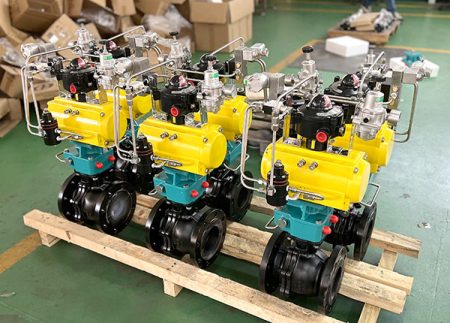
Actuated Valve Applications
Process Lines
Food, beverage, and manufacturing plants use actuated valves to keep lines clean and working well. These valves move raw ingredients and finished products. Operators use them to control liquids, syrups, and gases in clean places. The valve design stops food from getting stuck inside. This helps prevent germs from growing. Stainless steel and smooth surfaces make cleaning simple. These features help with clean-in-place routines. Utility valves help wash equipment and work areas to keep them clean.
Operators pick actuated valves that follow strict rules like FDA and EFSA. This makes sure every process is safe and keeps food safe for people.
Automation
Automation is very important in food and beverage plants today. Automated valves mean less manual work. This lowers the chance of germs and mistakes. Smart valve actuators connect to control systems. They let workers watch valves in real time and fix problems early. These systems help keep production running well. Robots and advanced automation help with fast packaging, filling, and mixing. This makes work faster and products better.
- Actuated valves help measure ingredients and control flow exactly.
- Smart controllers with wireless features let workers control things from far away and check data.
- Automation cuts downtime and keeps plants cleaner by having fewer people in work areas.
Valve Actuators Selection
Picking the right valve actuator is very important for food, beverage, and manufacturing jobs. Operators look at actuator type, power, speed, and if it works with control signals. Electromechanical actuators are popular because they move cleanly and do not leak. Their sealed design keeps things clean and safe. Pneumatic actuators work fast and can handle strong cleaning, so they are good for washdowns. Electric linear actuators are quiet and exact, which is good for careful jobs and product quality.
| Actuator Type | Key Features | Typical Use Cases |
|---|---|---|
| Electromechanical | Clean, programmable, leak-free, low maintenance | Ingredient dosing, flow control |
| Pneumatic | Fast, durable, washdown-ready, safe | Packaging, filling, mixing |
| Electric Linear | Quiet, precise, hygienic, easy integration | Automated process lines |
Key Benefits
Actuated valves give many good things to food, beverage, and manufacturing plants:
- They help keep things clean by working with automated CIP systems and needing less hand cleaning.
- Automated valves keep control steady, which makes products better and cuts waste.
- Working with robots and IIoT lets workers watch things in real time and change jobs quickly.
- Pneumatic and electric valve actuators work safely and reliably, even if the power goes out.
- These valves help plants follow rules and have less downtime.
Smart valve automation helps big factories make more with fewer mistakes and better safety. This is very important for modern process industries.
Mining & Nuclear
Applications
Critical Flow Control
Mining and nuclear industries need very careful flow control. They use valve actuators to change how fast fluids and gases move. This keeps work safe and helps things run well. These valves must work in tough places. Sometimes it is very hot or there is a lot of pressure. Sometimes the fluids are dangerous or even radioactive. The right valve actuators help keep things steady and stop accidents.
Safety Systems
Safety is always the most important thing in mining and nuclear work. Operators use valves to shut off flow, let out extra pressure, and stop backflow. These jobs keep workers and the environment safe from leaks or spills. Isolation valves can close off parts for fixing or in emergencies. Pressure relief valves open by themselves if there is too much pressure. Backflow prevention valves stop fluids from going the wrong way. This is very important to stop contamination.
Operators in nuclear plants and mines must pick valves that meet strict safety rules. These valves must also work in harsh places, like where there are earthquakes or strong chemicals.
| Application | Description | Safety-Critical Requirements Addressed |
|---|---|---|
| Flow Regulation | Controls how fast fluids or gases move in pipes. | Must work well in very hot, high-pressure, and corrosive places. |
| Isolation | Shuts off flow for fixing or emergencies. | Needs tight seals to stop leaks of dangerous or radioactive stuff. |
| Pressure Relief | Opens by itself to let out extra pressure and stop damage. | Must react fast and pass tough safety tests. |
| Backflow Prevention | Stops fluids from moving backward and causing contamination. | Must only let fluids go one way, which is key for safety. |
Valve Actuators Used
Valve actuators in mining and nuclear jobs must be strong and safe. Hydraulic actuators are good for mining because they give a lot of force. Pneumatic actuators are used in risky mining areas because they do not use electricity. This lowers the chance of sparks. In nuclear plants, electric actuators control important fluids with great care. Many systems use spring-return actuators for safety. These make valves go to a safe spot if power stops. Double-acting actuators give more power and control but need extra safety systems.
Operators pick actuators with flameproof covers and high protection ratings like IP67 or IP68. These covers keep out dust and water and stop fires in explosive places. Special oils help actuators work in very hot or cold places. This makes them last longer.
Advantages
Valve actuators give many good things to mining and nuclear work:
- They help automate jobs in tough places, so people do not have to work in danger.
- Motor and air-operated valves in nuclear plants help test the most important safety parts.
- This saves money on fixing things and keeps workers away from radiation.
- Risk checks help sort valves by safety level, so testing is better and rules are met.
- Studies from nuclear plants in Taiwan and the US show these ways make plants safer and work better.
- Using actuated valves helps follow strict rules from groups like the IAEA and NRC.
Actuated valves help mining and nuclear sites stay safe, reliable, and efficient, even when things get really tough.
Actuator Types & Selection

Electric
Electric valve actuators use motors to move valves very exactly. These actuators work well where things must stay clean and controlled. Many places like power plants, water plants, and medicine factories use electric valve actuators. They do not need air or fluid systems. They fit easily into digital controls, so people can check them from far away.
Operators like electric actuators because they save energy. They only use power when moving the valve, so this saves money. These actuators have fewer parts, so they last longer and need less fixing. They are also quiet, which is good in places where noise matters. But electric actuators need steady power. If the power goes out, they may stop unless there is backup. They also do not make as much force as hydraulic types, so they may not work for very big valves.
Tip: Electric valve actuators help lower downtime and make things safer. They let people control valves from far away and work with smart systems.
| Advantages | Limitations |
|---|---|
| Very exact and easy to control | Needs steady power |
| Saves energy and needs little fixing | Costs more at first |
| Quiet and clean when working | Not enough force for very big valves |
| Easy to use with digital controls | May get hot if used a lot |
| Good for the environment, no leaks | Needs experts for complex controls |
Pneumatic
Pneumatic valve actuators use air to move valves fast. These actuators are used a lot in chemical, food, and drink factories. They work quickly and can open and close many times without breaking. Pneumatic valve actuators are safe in dangerous places because they do not make sparks.
Operators pick pneumatic actuators because they cost less and are simple. They are easy to set up and fix. These actuators can keep working if the power goes out, as long as there is air. But they need a steady air supply, which makes things more complicated. Pneumatic actuators can be loud and lose power if air leaks. They also do not control as exactly as electric types.
- Advantages:
- Works fast and gives enough force
- Simple to set up and needs little fixing
- Safe for dangerous places
- Good price for many jobs
- Limitations:
- Needs air supply all the time
- Not as exact or easy to control
- Can be loud when working
- Loses energy if air leaks
Hydraulic
Hydraulic valve actuators use fluid under pressure to move valves with a lot of force. These actuators are best for big valves and high-pressure jobs, like in oil and gas pipes. Hydraulic valve actuators keep valves steady and working well, even in hard places. They can open and close valves quickly and handle heavy loads.
Operators use hydraulic actuators when they need strong force and safety. These actuators work well in faraway or hard-to-reach places. But hydraulic systems are harder and cost more to put in. There is also a chance of fluid leaks, which can cause fixing problems and hurt the environment.
| Actuator Type | What It Does | Good Things | Bad Things | Where Used |
|---|---|---|---|---|
| Electric | Uses a motor for exact moves | Needs little fixing, clean, very exact | Needs power, not strong enough for big valves | Power, water, medicine |
| Pneumatic | Uses air for fast opening and closing | Fast, safe, good price | Needs air, not as exact, can be loud | Chemical, food, drink |
| Hydraulic | Uses fluid for strong force | Very strong, steady, safe | Costs more, more parts, can leak | Oil, gas, big pipes |
Note: Picking the right valve actuator depends on valve size, needed force, where it is used, and how much control is needed.
Suitability
Picking the right actuator type is very important for safe work. Each actuator type has its own special strengths. Operators need to choose the one that fits their job best.
Key Factors for Actuator Selection:
- Load Capacity and Stroke: The actuator must lift or move what the job needs.
- Speed and Force: Some jobs need fast and strong movement. Others need slow and steady action.
- Power Source Availability: The choice depends on what power is at the site.
- Mounting Configuration: The actuator must be lined up and attached well.
- Actuation Features: Double-acting or spring-return changes how it works if power stops.
- Enclosure Protection Rating: Ratings like NEMA 4, 4X, or 7 show how well it keeps out dust and water.
- Environmental Conditions: The actuator must handle heat, cold, dust, and shaking.
- Safety Ratings: Some places need explosion-proof or water-safe designs.
- Cost and Maintenance: Think about price, fixing, and how much it costs to keep working.
Operators should always think about the place and safety before picking an actuator. For example, pneumatic actuators are good in places where things might explode. Electric actuators are better for clean rooms.
Comparison Table: Matching Actuator Types to Application Needs
| Application Need | Best-Fit Actuator Type | Reasoning |
|---|---|---|
| High precision, clean operation | Electric | Offers accurate control, energy efficiency, and clean performance |
| Fast, repetitive motion | Pneumatic | Delivers quick response and reliability, safe in explosive environments |
| Heavy-duty, high-force tasks | Hydraulic | Provides strong force in a compact size, ideal for large valves and loads |
| Sterile or clean-room settings | Electric | Clean, no risk of fluid leaks, easy integration with automation |
| Outdoor or hazardous locations | Pneumatic or Hydraulic | Withstands harsh conditions, offers fail-safe options |
| Limited space or weight | Electric or Pneumatic | Compact designs available, lightweight options |
Checklist for Matching Actuator to Application:
- Decide if you need straight or turning movement, or both.
- Find out how much force or turning power is needed.
- Check how fast the actuator must move.
- See what power and controls are at the site.
- Look for dangers and safety rules in the area.
- Think about price, fixing, and how long it will last.
Tip: Operators who pick the right actuator for their job get better results, more safety, and less fixing.
By thinking about these things, operators can pick the actuator that works best for their job. This helps make sure valve automation is safe and works well.
Integration & Customization
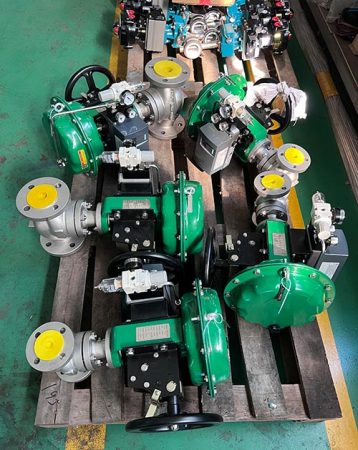
Safety Features
Modern actuation systems must follow strict safety rules. Operators pick actuators that fit the place they will be used. They look at things like heat, water, or if there are explosive gases. Actuators with the right enclosure ratings keep people safe in risky areas.
Some important safety features in valve systems are:
- Fail-safe parts like battery backups and spring return systems. These move the valve to a safe spot if power goes out. This stops the flow from getting out of control.
- Limit switches keep the valve from moving too much or too little. This helps stop accidents and broken parts.
- Self-check tools find problems early. Operators can fix things before they break.
- Strong covers with high IP ratings block dust and water. This helps actuators work well in hard places.
- Connecting to control systems lets people run valves from far away. It also gives real-time updates and cuts down on mistakes.
Safety features in actuation systems protect workers, machines, and nature. They also help companies follow the rules.
Control Systems
Industrial sites often link valve actuators to smart control systems. DCS and PLC send signals to actuators. These tell the valve when to open or close. This setup lets the whole system work together and on time.
Some good things about using control systems are:
- Operators can change valve settings from far away. This means less work by hand.
- Automated systems make things more exact and accurate. Each valve can do what the process needs.
- Remote control keeps workers away from danger. This makes everyone safer.
- Plants can work better and make more by running valves at the best times. This saves energy and cuts waste.
- The system gives lots of data for planning repairs. Teams can fix things before they break and stop work.
Connecting valves to control systems makes plants work better. It helps them be safer, faster, and cost less.
Custom Solutions
Every industry has its own problems to solve. Customization makes sure each valve and actuator fits the job. Engineers can use special materials, different ways to mount, or new ways to talk to other machines.
Some common customizations are:
- Special coatings for valves that touch harsh fluids.
- Custom covers for actuators in very hot or cold weather.
- Linking with plant software or special monitoring tools.
- Unique fail-safe settings for what the process needs.
Custom solutions help operators get the best results and reliability. They also make it easier to follow safety and green rules.
Actuated valves are very important in many industries like oil and gas, power plants, chemical factories, and water treatment. Electric, pneumatic, and hydraulic actuators each have their own good points for moving water, making things safer, and helping with automatic systems. Picking the right actuator helps things work well and follow the rules. Experts say it is smart to ask professionals to help choose the best actuator valve for each job. Companies that pick the right size and take care of their valves have fewer problems and work better.
FAQ
What is an actuated valve?
An actuated valve has a device called an actuator. The actuator opens or closes the valve by itself. This helps control how liquids or gases move in factories.
Why do industries use actuated valves?
Industries use actuated valves to make work safer and faster. These valves also help workers do less by hand. Automated control lets the system react quickly and manage flow better.
Which actuator type works best for hazardous environments?
Pneumatic actuators are best for dangerous places. They use air, so they do not make sparks. This keeps things safer where explosions or fires could happen.
How do actuated valves support remote monitoring?
Operators connect actuated valves to control systems. This lets them watch and change valve positions from far away. It keeps workers safe and means fewer people need to be on site.
Can actuated valves handle high-pressure applications?
Yes, hydraulic actuators are strong for high-pressure jobs. They work well in oil, gas, and power plants. These actuators move big valves even when conditions are tough.
What maintenance do actuated valves require?
Workers need to check seals, test how the actuator moves, and clean parts. Doing this often stops problems and helps the valve last longer.
Are actuated valves suitable for cleanroom environments?
Electric actuators are good for cleanrooms. They do not use fluids or air, so they keep things clean. Their sealed design helps meet hygiene and quality rules.
How do actuated valves help meet safety regulations?
Automated valves act fast in emergencies. Features like fail-safe spots and remote control help follow safety rules. They also protect workers and equipment.
